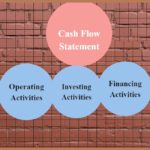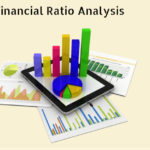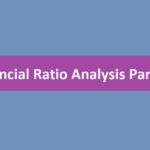Role of Finacial Ratio in Fundamental Analysis
In the last few chapters, we have learned to read financial statements. Now we will learn to analyze or analyze them. For this we have to first understand the financial ratio. The financial ratio was first coined by a fundamental analyst named Benjamin Graham. He is considered as the father of financial ratio. Through financial ratio we can assess the financial results of the company. The current performance can be measured against the performance of previous years, previous quarters and other companies.
Financial ratios usually refer to the data from a company’s financial statements or financial statements. Before understanding the financial ratio, we need to know some of its important principles.
Financial ratios in themselves do not give much information. For example, if I am told that UltraTech Cement has a profit margin of 15%, what will I know? It is true that a profit of 15% is a good profit, but is it the best profit in the sector?
Suppose you know that the profit of ACC Cement is 12% and when we compare this profit with the profit of UltraTech Cement, we will come to know that the profit of UltraTech is higher than that of ACC Cement. It may have been said that the ratio itself doesn’t tell much, but when it is used for comparison, you get the complete picture. This means that whenever you calculate the ratio, then if you use it for any comparison, then it will be better.
Another important thing that you must remember while working out the ratio is that every company has its own different accounting policy. Accounting policies may also differ in different financial years. That’s why you should be aware of this while using ratios.
Financial Ratio
Broadly, the financial ratio can be divided into 4 parts.
- Profitability Ratios
- Leverage Ratios
- Valuation Ratio and (Valuation Ratios)
- Operating Ratios
Profitability Ratio, as the name suggests, the profitability ratio shows the profitability of the company. It also shows how well the company is doing, how good is its management? Profitability means that the plans for expansion of the company are run by profit, the dividend is given to the shareholder, so profit or profit is the most important ratio for the shareholder.
The leverage ratio is sometimes also called the solvency ratio or gearing ratio. This ratio shows how well the company can run its business for a long time in the coming time. It also shows how much debt the company is using for its expansion. Remember that a company has to pay many bills and fulfill its other responsibilities in order to run its business properly. The solvency ratio gives us an idea of how well the company is capable of meeting these responsibilities.
The valuation ratio is used to compare the price of a company’s shares with its profits. It shows whether the price of the company’s shares is less or more than its profit. Are shares expensive or cheap? It also gives an idea of what the total real value of the company is and the value of the shares against it. This ratio of the company is seen very closely before buying shares.
The operating ratio, also called the activity ratio, tells how well a company can use its assets to grow its business. It also shows how the company is managed. That is why sometimes it is also called Management Ratio.
In fact, every ratio gives a message about the financial condition of a company just like the profitability ratio tells about the efficiency of the company’s operations. Sometimes it is also known by the operating ratio. That is why dividing the ratio into different categories is a bit difficult task, but still they can be broadly divided into the four parts mentioned above.
Profitability Ratio
Under the profitability ratio, we will look at the following ratios:
1. EBITDA Margin (Operating Profit Margin)
– EBITDA Growth Rate (CAGR Growth)
2. PAT Margin
– PAT Growth Rate (CAGR Growth)
3. Return on Equity (ROE)
4. Return on Asset (ROA)
5. Return on Capital Employed (ROCE)
EBITDA Margin :
The Earnings Before Interest Tax Depreciation and Amortization (EBITDA) margin measures the efficiency of a company’s management. It also tells how the business of the company is doing. How much profit (in percentage) is the company making in business? By comparing this margin of the company with that of other company, we get to know how the company is keeping its expenses under control.
To know the EBITDA margin, we have to first find the EBITDA of the company.
EBITDA = [Operating Revenues – Operating Expenses]
Operating Income = [Total Revenue – Other Income]
Operating Expense = [Total Expense – Finance Cost – Depreciation & Amortization]
EBITDA Margin = EBITDA / [Total Income – Other Income]
For example, let’s calculate the EBITDA margin of Amara Raja Batteries for FY14:
First EBITDA :
[Total Income – Other Income] – [Total Expenditure – Finance Cost – Depreciation and Amortization]
Remember that other income comes from investments and other non-business sources, so including it in EBITDA may not give a true picture.
[3482-46] – [2942-0.7-65]
= [3436] -[2876]
= Rs 560 crore
EBITDA Margin 560/3436 = 16.3%
There are 2 questions here:
- What does an EBITDA of Rs 560 crore indicate and what does an EBITDA margin of 16.3% represent?
- EBITDA Margin of 16.3% Good or Bad?
The answer to the first question is simple. This also means that the company spent 2876 crores out of the income of ₹3436. In percentage terms, the company spent 83.7% of its revenue and saved 16.3% of its revenue for business.
Now let’s see the answer to the second question. We have mentioned earlier that financial ratios by themselves do not give any specific information. To extract work information from it, we have to compare it with the previous year or with any other company. To understand the meaning of the company’s 16.3% EBITDA margin, let us look at the 4-year trend of Amara Raja Battery EBITDA margin.
| Year | Operating Income | Operating Expense | EBITDA | EBITDA Margin |
| 2011 | 1761 | 1504 | 257 | 14.6% |
| 2012 | 2364 | 2025 | 340 | 14.4% |
| 2013 | 2959 | 2508 | 451 | 15.2% |
| 2014 | 3437 | 2876 | 560 | 16.3% |
ARBL’s EBITDA seems to be generally hovering around 15% on an average. A closer look shows that its EBITDA margin is increasing gradually. This is a good sign which indicates that the performance of the company is not only stable but also improving continuously. It also shows the efficiency of the management of the company.
The company’s EBITDA in the year 2011 was Rs.257 crores and in 2014 it is at Rs.560 crores. This means that the CAGR growth of EBITDA in 4 years has been 21%.
It is clear that the EBITDA margin and EBITDA CAGR growth are all pretty good. But we don’t know how it compares to other companies. In case of ARBL, you should compare it with the EBITDA of Exide Batteries Ltd.
PAT Margin
The EBITDA margin is measured at the company’s business or operating level, while the PAT margin is viewed as the company’s final profit. In operating margin, we only include operating expenses, it does not include depreciation and financial costs. Tax expenses also remain separate whereas PAT includes all these in the margin. When the PAT margin is calculated, all expenses are deducted from the total income, then the total final profit of the company is found.
PAT Margin = [PAT / Total Revenue]
The company’s PAT is very clearly stated in the annual report. This PAT of ARBL for FY14 was Rs 367 crores while the company’s income was Rs 3482 crores. The company’s PAT margin is based on:
367 / 3482
= 10.5%
Let’s take a look at how ARBL’s PAT and PAT margins have been over the years:
| Year | PAT (crores) | PAT Margin |
| 2011 | 148 | 8.4% |
| 2012 | 215 | 8.9% |
| 2013 | 287 | 9.6% |
| 2014 | 367 | 10.5% |
The performance of the company’s share and PAT margin is looking very good. We can see that the margin of the company is increasing continuously, it is growing at CAGR of 25.48% in the last 4 years which is quite good. But we will get to know the true picture only after comparing it with other competing companies.
Return on Equity (ROE)
Return on Equity is a very important ratio that tells us how much the shareholders of the company are earning on their investments. It tells how much profit the company is making on the investment of the shareholders. The higher the ROE, the better it is for the shareholders. This becomes a very important basis for identifying a truly investible company. For your information, the best companies in India have an ROE in the range of 14% to 16%, but personally I prefer those companies whose ROE is more than 18%.
This ratio is also compared with other companies operating in that industry. It is also compared with past historical data.
Also note that higher ROE means that the company is getting a lot of cash and the need for the company to borrow or raise money from outside is going to be less. So a good ROE means that the management of the company is doing a good job.
ROE Equation: [ Net Profit / Shareholders Equity *100]
ROE is a good ratio but like many other ratios it also has some drawbacks. Let us see an example to understand them better.
Suppose Vishal runs a pizza store. To make pizza, he needs an oven which costs ₹ 10000. The oven is an asset to Vishal. He does not take any loan to buy it, but buys it with his own money. In such a situation, the shareholder equity on its balance sheet will be ₹ 10000 and the assets will also be ₹ 10000.
Now suppose Vishal makes a profit of ₹ 2500 in the first year of business. What happened to his ROE? It’s quite easy:
ROE = 2500 /10000 *100 =25.0%
Now let’s change the situation a little. Suppose Vishal has ₹8000 and he takes ₹2000 loan from his father so that he can buy an oven for ₹ 10000. What will his balance sheet look like now? The liability portion of the balance sheet will have shareholder equity of ₹8000 and debt of ₹2000. Thus, the total liability of Vishal will be ₹ 10000. On balancing this, he will also have assets of ₹ 10000 in the asset share. Now let’s see what his ROE is:
As part of the liability he will have:
Shareholders Equity = Rs.8000
Debt = Rs.2000
Now the total liability of Vishal is Rs. 10000 and the assets are also Rs. 10000. Now let’s see ROE:
ROE = 2500/ 8000*100
=31.25%
Due to this loan, the ROE of Vishal has increased significantly. Now suppose Vishal had only ₹ 5000 and had to take a loan of ₹ 5000 from his father, then what would his balance sheet look like? In his share of the liability he would have had:
Shareholders Equity = ₹5000
Loan = ₹5000
Overall his liability would have been ₹ 10000 and his asset share would also be ₹ 10000
So what does his ROE look like?
ROE =2500 / 5000*100
= 50%
You can see that as Vishal’s debt continues to grow, so does his ROE. High ROE is good but not with debt because as debt increases, it becomes risky to run a business as the financial cost increases. A good way to do this is to implement the DuPont Model, also known as DuPont Identity.
This model was developed in 1920 by a company named DuPont. In this model, the ROE formula is divided into three parts and each part represents a specific part of the business. DuPont analysis uses both a business’s balance sheet and P&L statement.
Under this model, ROE is calculated as follows:
 If you look carefully, in this formula, the numerator and denominator (Denominator & Numerator) intersect and at the end we are left with the original ROE formula:
If you look carefully, in this formula, the numerator and denominator (Denominator & Numerator) intersect and at the end we are left with the original ROE formula:
ROE = Net Profit / Shareholders Equity *100
But the advantage of this is that we get to look at three different parts of the business. Let’s look at the three parts of this model:
Net Profit Margin = Net Profit / Net Sales * 100
This is the first part of the DuPont model that shows the company’s ability to make profits. But in reality it is nothing but PAT margins whose low cost means that the company is costing more and is facing a tough competition.
Asset Turnover = Net Sales / Average Total Asset
Asset turnover ratio shows how well a company is using its assets to increase its revenue. The higher this ratio, the more efficient the company is considered. When this ratio is low, it is believed that the management of the company is not good or there is a problem in its production. To show this, the number of years is given.
Financial Leverage = Average Total Assets / Shareholders Equity
In Financial Leverage Ratio, we find out how much per unit of assets the company has per unit of shareholder equity of the company. For example, if the financial leverage is 4, it means that for every ₹1 of equity, the company has an asset of ₹4. If the financial leverage ratio of the company is high and the company has taken a lot of debt, then investors should be careful while investing in such company.
As you can see, the DuPont model divides the ROE formula into three distinct parts, each providing a picture of a company’s performance and financial capability.
Now we use this model to calculate the FY14 ROE of Amara Raja battery.
Net Profit Margin: As mentioned earlier this is nothing but PAT margin. We have already worked out the PAT margin of Amara Raja Batteries i.e. ARBL and it is 9.2%.
Asset Turnover = Net Sales / Average Total Assets
We know that as per the Annual Report of FY14, the total sales of ARBL is Rs.3437 crores.
Here the average is the total asset as the denominator. We know that we can calculate assets from the balance sheet, but what does average mean here?
The total assets shown in the Balance Sheet of ARBL are Rs.2139 crores. But the point to note here is that this figure is for the financial year 2014 which starts on 1st April 2013 and ends on 31st March 2014. This means that when the company started operations at the beginning of the financial year (April 2013), it had some assets which were from FY13 and which were carried forward from there. Later (in FY14) some new assets were also added and all these assets together amounted to Rs 2139 crore. This means that the assets held by the company at the beginning of the year were worth something else and at the end of the year the assets were worth something else.
Keeping this in mind, we will now work out the asset turnover ratio, so which value of the asset should we take now – the year-end or the year-end price? To overcome this dilemma, the average price of the asset is worked out.
Remember this technique of averaging a line item will have to be used to calculate other ratios as well. We know from the ARBL Annual Report that:
FY14 Net Sales = Rs 3437 crore
FY13 Total Assets = Rs.1770 Crore
FY14 Total Assets = Rs 2139 crore
Average Total Assets = (1770+2139) / 2
= 1995
Asset Turnover = 3437 / 1995
= 1.75
This means that for every Re 1 of the asset, the company is earning Rs 1.75.
Now let’s calculate the final part of the financial leverage:
Financial Leverage = Average Total Assets / Shareholders Equity
We know that the average value of the total asset is Rs 1955 crore. All we have to do is take out the shareholder equity. Just as we have looked at the average assets instead of looking at the current assets, we will look at the average shareholders equity and not just the shareholders equity of the current year.
FY13 Shareholders Equity = Rs 1059 crore
FY14 Shareholders Equity = Rs 1362 crore
Average Shareholders Equity = Rs 1211 crore
Financial Leverage = 1955 / 1211
= 1.61
Since ARBL has very low debt, the financial leverage is 1.61 which is a good figure. This means that against every rupee equity held by the shareholder, ARBL has assets worth Rs 1.61.
Now we find the ROE of ARBL :
ROE = Net Profit Margin x Asset Turnover x Financial Leverage
= 9.2%*1.75*1.61
– 25.9%
This is a long way to get this ROE. But it is probably also the best way because because of this we can get a good idea about many different parts of any business. The DuPont model not only tells us about a company’s returns but also the quality of that return.
Well, if you’re in a hurry to calculate ROE, use this equation:
ROE = Net Profit / Average Shareholder Equity
According to the annual report, the PAT of FY14 is 367 crores
ROE=367 / 1211
= 30.31%
Return on Asset (ROA)
After understanding the DuPont model, it will be easy to understand the next two financial ratios. Return on Asset or ROA tells us how much profit a company can make by using its assets. A good company does not invest in an asset that does not benefit it, so ROA tells us what kind of assets the company’s management is investing in. The higher the ROA of the company, the better it is for the company.
ROA = [Net Income + Interest *(1-Tax Rate)] / Total Average Assets
According to the annual report:
FY14 Net Income = 367.4 Crore
Total Average Assets we worked out = 1955 crores
But what does interest *(1-tax rate) mean here? Just imagine, the assets that will be bought from the loan taken by the company will be used by the company to earn profit. So in this way those people also become the shareholders of the company who have given loan to the company. Also the company has to pay less tax as interest has been paid. This is called tax shield. Because of this, whenever we calculate the ROA of the company, we also have to add the interest (from the point of view of tax shield).
If the total interest (finance cost) is 7 crores, then the tax shield will be :
= 7 *(1-32%), here the average tax rate is assumed to be 32%.
=4.76 crore,
So,
ROA = [367.4 + 4.76] /1955
~ 372.16 / 1955
~19.03%
Return on Capital Employed (ROCE)
Return on Capital Employed tells us how much profit the company is making from the amount of capital or capital employed in the company. Total capital or capital includes both equity and debt i.e. equity and debt.
ROCE = [Profit before Interest & Taxes / Total Capital Employed]
Total Capital Employed = Short Term Debt + Long Term Debt + Equity
According to the annual report of ARBL:
Profit before interest and tax = 537.7 crore
Total Capital Employed:
Short term loan = 8.3 crore
Long term loan = 75.9 crore
Shareholder Equity = 1362 Crore
Total Capital Employed : 8.3 + 75.9 + 1362 = 1446.2 Crore
ROCE = 537.7 / 1446.2
= 37.18 %
Highlights of this chapter
- Financial ratio is a very important way to measure or measure any company but financial ratios themselves give very little information.
- The best use of the ratio is when you compare it with past data or with any other company in the industry which is competing with this company.
- The financial ratio can be divided into 4 parts namely profitability, leverage, valuation and operating ratio.
- These four parts give different information about the company to an analyst.
- The amount left after deducting operating expenses from operating earnings is called EBITDA.
- The EBITDA margin shows a company’s percentage profit at the operating level.
- PAT margin shows the total profit of the company.
- Return on Equity (ROE) is a very important ratio which tells how much money the shareholders of the company are earning on the initial investment.
- A high ROE and high debt is not a very good sign.
- The DuPont model is used to divide the company’s ROE into different parts, which gives a better understanding of the different parts of the company’s business.
- The DuPont model is probably the best model to calculate the ROE of a company.
- Return on asset tells how well the company is using its assets.
- Return on Capital Employed describes how the company is using its debt and equity and the return it is earning.
- Any ratio is of good use when it is used in comparison to some method.
- Ratios can be used for a point-of-a-time comparison and also for a long-term comparison.

Gaurav Heera is a leading stock market educator, offering the best stock market courses in Delhi. With expertise in trading, options, and technical analysis, he provides practical, hands-on training to help students master the markets. His real-world strategies and sessions make him the top choice for aspiring traders and investors.





